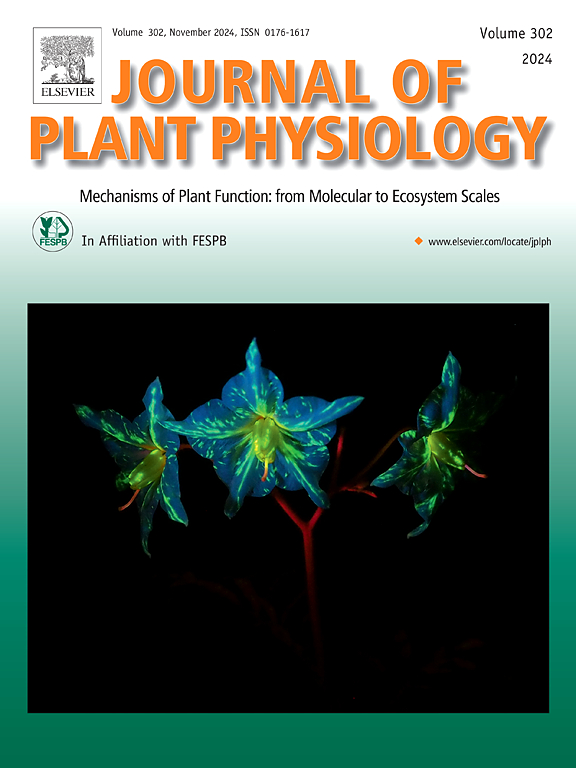PRLIP2基因的插入突变改变了拟南芥的激素平衡和防御反应
IF 4.1
3区 生物学
Q1 PLANT SCIENCES
引用次数: 0
摘要
之前,我们的研究小组通过对拟南芥进行差异筛选,发现了一个负责编码致病相关脂酶样蛋白(PRLIPs)的新基因家族,这些拟南芥被抗性诱导化合物β-氨基丁酸(BABA)预处理。在目前的研究中,我们描述了两个独立的拟南芥突变系,它们的PRLIP2基因中有T-DNA插入。两个prlip2突变系对强毒性半生物营养细菌病原体丁香假单胞菌pv的敏感性增强。DC3000和不能表达baba诱导的抗性。这种易感性的增加与PTI标记基因FRK1 (flg22诱导的受体KINASE1)和NHL10 (NDR1/ hin1样10)的表达减少以及PR1(致病相关蛋白1)的低表达有关,PR1是水杨酸(SA)信号的标记基因。相比之下,茉莉酸(JA)/乙烯(ET)信号通路在突变体中上调。此外,PRLIP2基因突变导致植物生长加快,生长素含量增加。此外,突变系中生长素水平的升高可能抵消了SA的反应,从而上调了茉莉酸(JA)信号。虽然PRLIP2在植物防御反应中作为生长素的负调节因子的重要作用已被清楚地证明,但这种导致激素平衡分化的现象背后的确切分子机制仍未完全阐明。本文章由计算机程序翻译,如有差异,请以英文原文为准。
The role of PRLIP2 in the defence and growth of Arabidopsis Insertional mutagenesis of PRLIP2 gene alters hormone balance and defence responses in Arabidopsis
Previously, our group identified a novel gene family responsible for encoding pathogenesis-related lipase-like proteins (PRLIPs) through a differential screening process involving Arabidopsis plants that were pre-treated with the resistance-inducing compound β-aminobutyric acid (BABA). In the present study we have characterized two independent mutant lines of Arabidopsis possessing T-DNA insertion in their PRLIP2 gene. Both prlip2 mutant lines displayed enhanced susceptibility to the virulent hemibiotrophic bacterial pathogen Pseudomonas syringae pv. DC3000 and were incapable of expressing BABA-induced resistance. This increased susceptibility was associated with a reduced expression of the PTI marker genes FRK1 (FLG22-INDUCED RECEPTOR KINASE1) and NHL10 (NDR1/HIN1-like 10) and a low expression of PR1 (PATHOGENESIS-RELATED PROTEIN 1), a marker gene for salicylic acid (SA) signalling. In contrast, the jasmonic acid (JA)/ethylene (ET) signalling pathway was up-regulated in the mutants. In addition, the mutation in the PRLIP2 gene resulted in increased plant growth and augmented auxin content. Furthermore, the elevated auxin levels in the mutant lines might counteract the SA responses, consequently up-regulating jasmonic acid (JA) signalling in these mutants. While the significant role of PRLIP2 as a negative regulator of auxin in plant defence responses has been clearly demonstrated, the precise molecular mechanisms underlying this phenomenon, which leads to divergent hormonal balance, remain incompletely elucidated.
求助全文
通过发布文献求助,成功后即可免费获取论文全文。
去求助
来源期刊

Journal of plant physiology
生物-植物科学
CiteScore
7.20
自引率
4.70%
发文量
196
审稿时长
32 days
期刊介绍:
The Journal of Plant Physiology is a broad-spectrum journal that welcomes high-quality submissions in all major areas of plant physiology, including plant biochemistry, functional biotechnology, computational and synthetic plant biology, growth and development, photosynthesis and respiration, transport and translocation, plant-microbe interactions, biotic and abiotic stress. Studies are welcome at all levels of integration ranging from molecules and cells to organisms and their environments and are expected to use state-of-the-art methodologies. Pure gene expression studies are not within the focus of our journal. To be considered for publication, papers must significantly contribute to the mechanistic understanding of physiological processes, and not be merely descriptive, or confirmatory of previous results. We encourage the submission of papers that explore the physiology of non-model as well as accepted model species and those that bridge basic and applied research. For instance, studies on agricultural plants that show new physiological mechanisms to improve agricultural efficiency are welcome. Studies performed under uncontrolled situations (e.g. field conditions) not providing mechanistic insight will not be considered for publication.
The Journal of Plant Physiology publishes several types of articles: Original Research Articles, Reviews, Perspectives Articles, and Short Communications. Reviews and Perspectives will be solicited by the Editors; unsolicited reviews are also welcome but only from authors with a strong track record in the field of the review. Original research papers comprise the majority of published contributions.
 求助内容:
求助内容: 应助结果提醒方式:
应助结果提醒方式:


